Key takeaways:
- Healthy eating revolves around balance, variety, and moderation, emphasizing the joy and pleasure in food.
- Intuitive eating encourages listening to internal hunger signals and honoring cravings, promoting a positive relationship with all foods.
- Overcoming food restrictions, like limiting gluten or sugar, can enhance overall happiness and well-being through moderation.
- Embracing flexibility in food choices allows for creativity and satisfaction, fostering a deeper connection with meals.
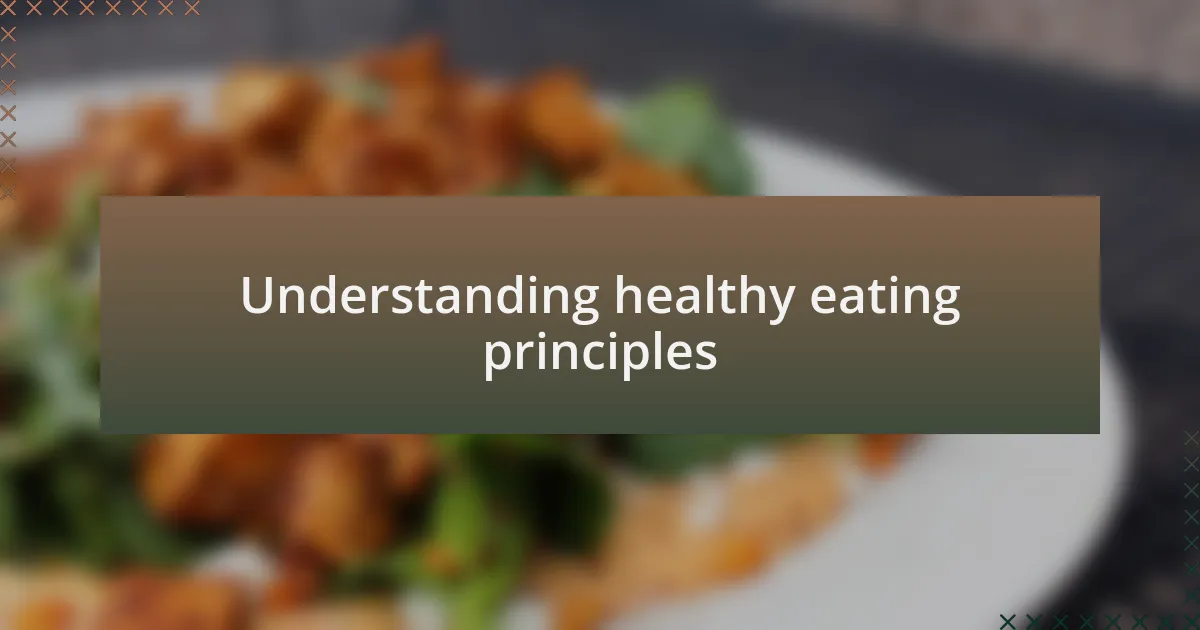
Understanding healthy eating principles
Healthy eating principles center on balance, variety, and moderation. In my own journey, I’ve realized that it’s not just about choosing the right foods but also about how those foods make me feel. Have you ever thought about how a meal affects your energy levels or mood? I have, and incorporating a mix of whole grains, lean proteins, and colorful fruits and vegetables has been transformative for me.
I also learned the importance of listening to my body. Initially, I struggled with external cues about what or how much to eat—leaving me confused and unfulfilled. I remember one day when I decided to skip the strict rules and just eat what I craved: a vibrant salad topped with quinoa and avocado. That meal not only nourished my body but also brought me joy, reinforcing the idea that healthy eating can—and should—be pleasurable.
Another principle I’ve embraced is the significance of mindful eating. I’ve found that taking the time to savor each bite truly enhances the experience and contributes to better digestion. Have you ever noticed how rushing through meals often leads to overeating? I did! It’s amazing how a simple shift in my eating habits has allowed me to appreciate food in a completely new way.
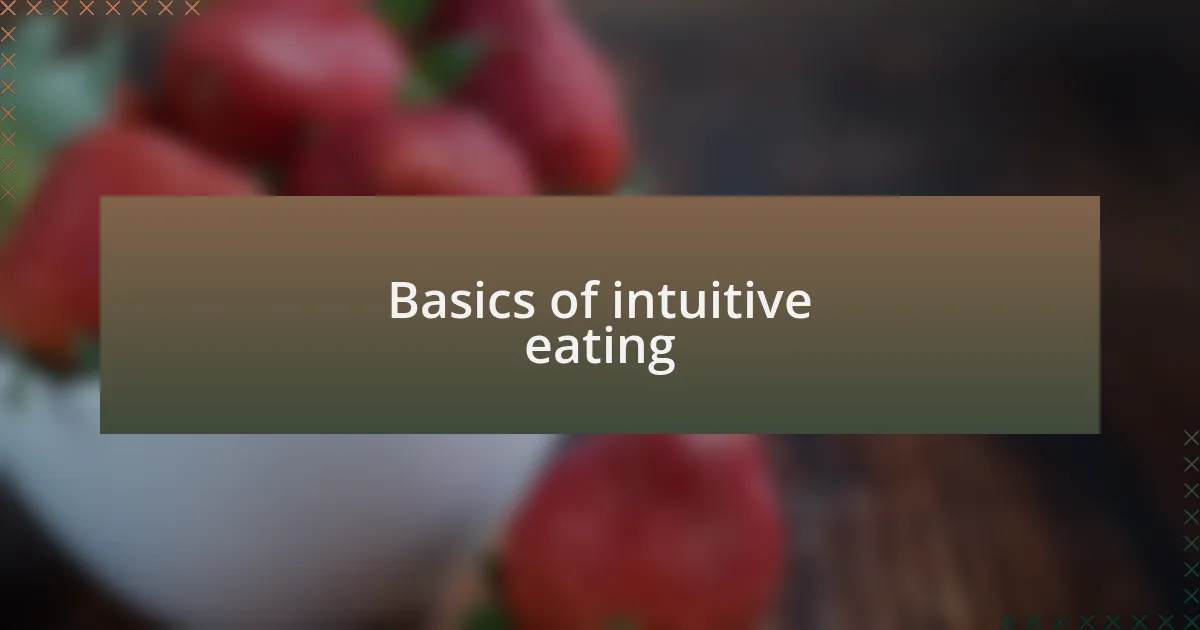
Basics of intuitive eating
Intuitive eating is built on the foundation of tuning in to your body’s internal signals. For me, this meant breaking free from the rigid diets that dictated what I could or couldn’t eat. Have you ever felt the freedom of listening to your body’s hunger cues instead of relying on external rules? I remember the first time I allowed myself to eat when I was genuinely hungry instead of at scheduled times—it felt liberating.
Another essential aspect of intuitive eating is recognizing and honoring cravings. In my experience, cravings are often a clue about what my body truly needs. One evening, I suddenly craved something sweet, so I decided to indulge in a piece of dark chocolate instead of denying myself. That small choice taught me a powerful lesson: satisfying cravings can be part of a balanced approach to eating, rather than an obstacle.
Lastly, it’s crucial to let go of the notion of good or bad foods. I often remind myself that labeling foods can create an unhealthy relationship with eating. Have you ever felt guilt after enjoying a treat? Shifting my mindset allowed me to view all foods as valuable, each one contributing to my overall well-being in its own way, whether it’s through pleasure or nourishment. This perspective has completely reshaped how I approach meals and snacks.
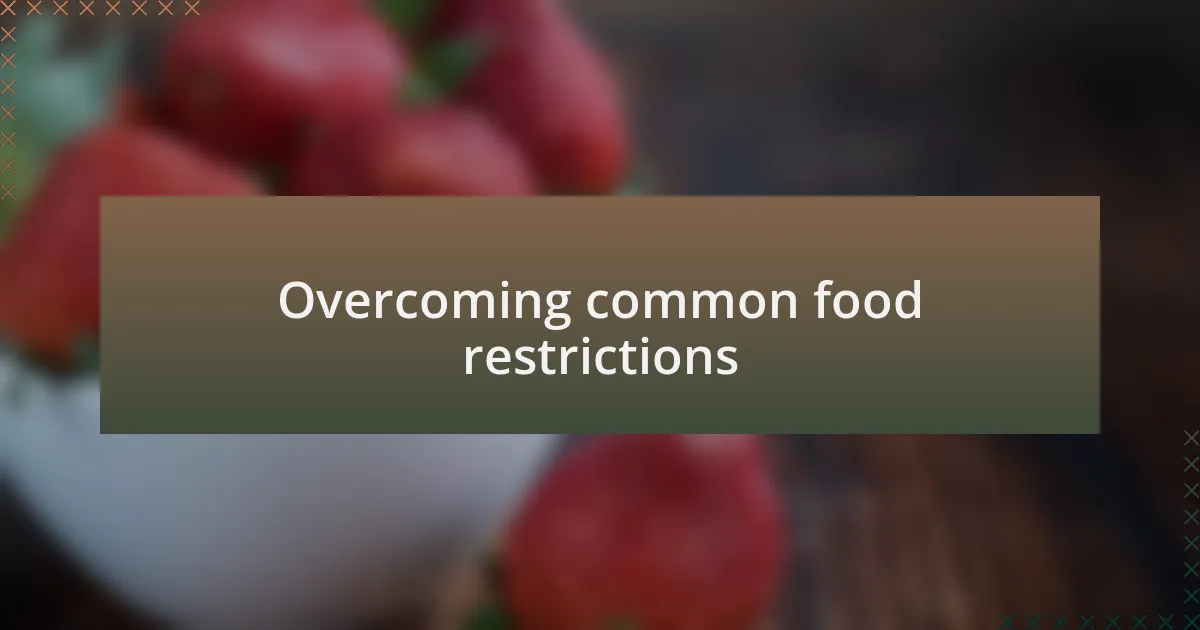
Overcoming common food restrictions
When it comes to overcoming common food restrictions, I’ve realized that fear often drives our choices. For a long time, I avoided gluten, thinking it was the source of all my digestive issues. One day, after feeling particularly adventurous, I decided to try a gluten-containing dish while out with friends. The experience was eye-opening; I learned that my body could handle it more than I expected, and it brought joy during a meal shared with loved ones.
Another restriction I faced was the idea of limiting sugar entirely. I thought that any form of sugar was simply off-limits if I wanted to eat healthily. However, I’ve come to understand that moderation is key. I recall attending a birthday party where I allowed myself a slice of cake. The taste was delightful, and enjoying it without guilt made it a memorable experience. It taught me that treating myself occasionally can enhance not just my palate but also my overall happiness.
Lastly, I’ve struggled with the restriction of avoiding fats, thinking I needed to eliminate them to stay healthy. But through my journey, I discovered that healthy fats, like those from avocados and nuts, are essential for overall well-being. One day, I whipped up a creamy avocado toast topped with seeds. It was nourishing and satisfying, reminding me that embracing these foods only enriches my relationship with food instead of limiting it. Have you ever felt the relief of letting go of such restrictions? I certainly have, and it’s been a transformative part of my intuitive eating journey.
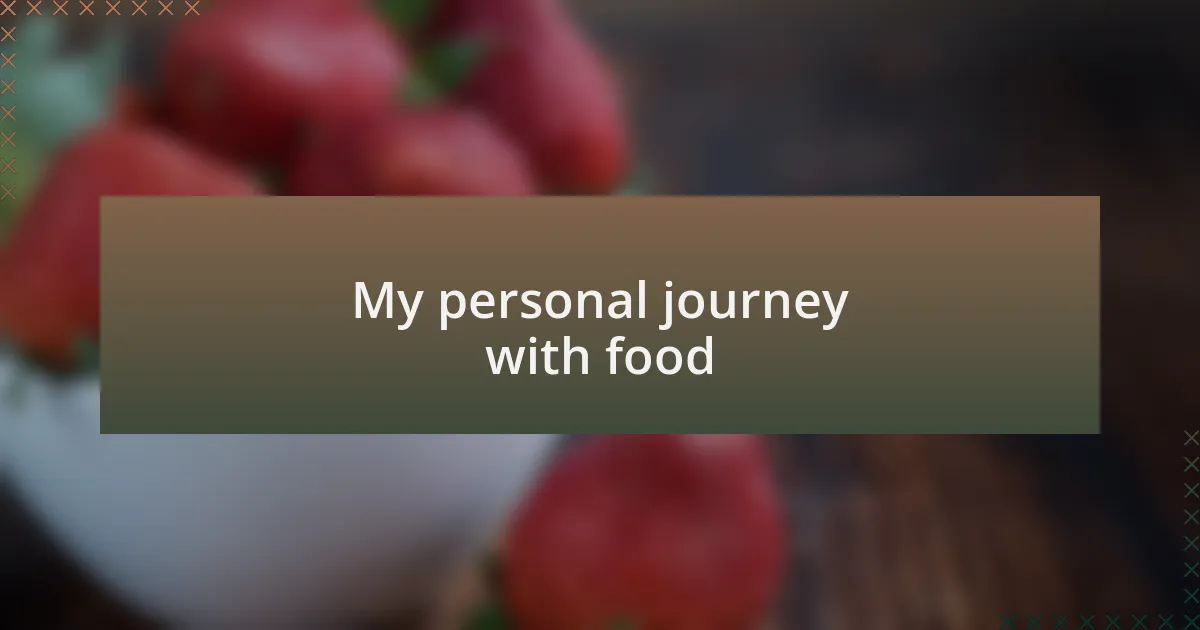
My personal journey with food
My relationship with food has always been a bit of a rollercoaster. I remember a time when food was more about rules than enjoyment. I used to meticulously count calories and obsess over portion sizes, which made every meal feel like a chore rather than a pleasure. When I finally allowed myself to listen to my cravings, it was as if a heavy weight lifted off my shoulders. Have you ever felt that sense of liberation when you just let go? It changed everything for me.
One vivid memory stands out as a turning point in my journey. On a sunny afternoon at a family picnic, I filled my plate with an array of dishes—homemade pasta, fresh fruit, and my grandmother’s famous pie. I hesitated for a moment, concerned about my choices. But then, I took a breath and decided to enjoy each bite fully. The flavors were a celebration of family and love, and in that moment, I realized that food could be an expression of joy rather than just fuel. It was a revelation I still cherish.
Then there was the day I discovered cooking from the heart. I was experimenting with a new recipe for a comforting stew. As the aroma filled my kitchen, I felt connected not only to the food but to the memories tied to those ingredients. Each chop of the vegetable brought back a sense of nostalgia and warmth. It was in that moment I understood that eating isn’t just about necessity; it’s about the stories we create with every meal. So, how do you define your meals? Do they tell a story, too?
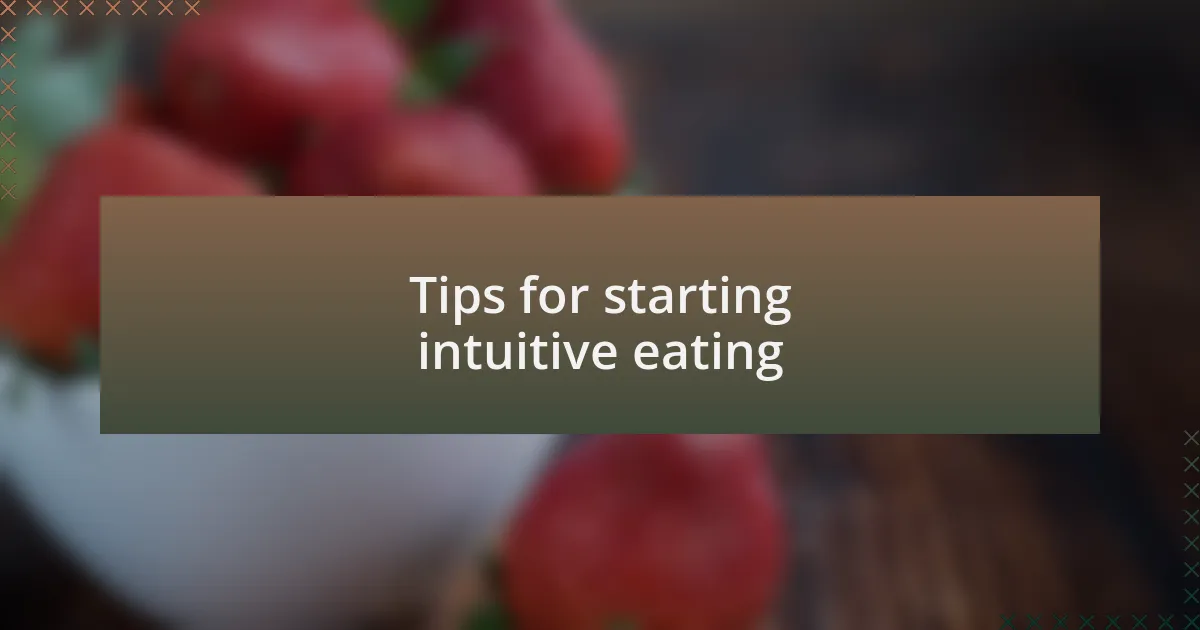
Tips for starting intuitive eating
To embark on your journey of intuitive eating, it’s essential to start by tuning into your body’s hunger signals. I remember the first time I focused on what my body truly needed rather than what was on my meal plan. It felt strange to ignore the clock and instead let my stomach guide me. How often do we eat just because it’s “time”? Allowing myself to skip a snack when I wasn’t hungry was liberating and taught me to respect my cravings.
Another important tip is to cultivate a non-judgmental mindset around your food choices. I used to experience guilt whenever I indulged, constantly replaying the moment in my head as if I had committed a crime. Now, I embrace the idea that all foods can fit into a balanced diet. Have you ever felt that guilty tug after enjoying a treat? Shifting your perspective to view all food as an opportunity for pleasure can change your entire relationship with eating.
Lastly, experiment with mindful eating practices. One afternoon, I decided to fully engage my senses during lunch. I closed my eyes as I took a bite, savoring the texture and flavors, and I was amazed at how much more satisfying the experience was. It made me realize that slowing down is key. When you eat mindfully, you cultivate a deeper appreciation for your meals and, in turn, for your body’s needs. How could a simple pause during your meal transform your eating experience? It’s worth finding out.
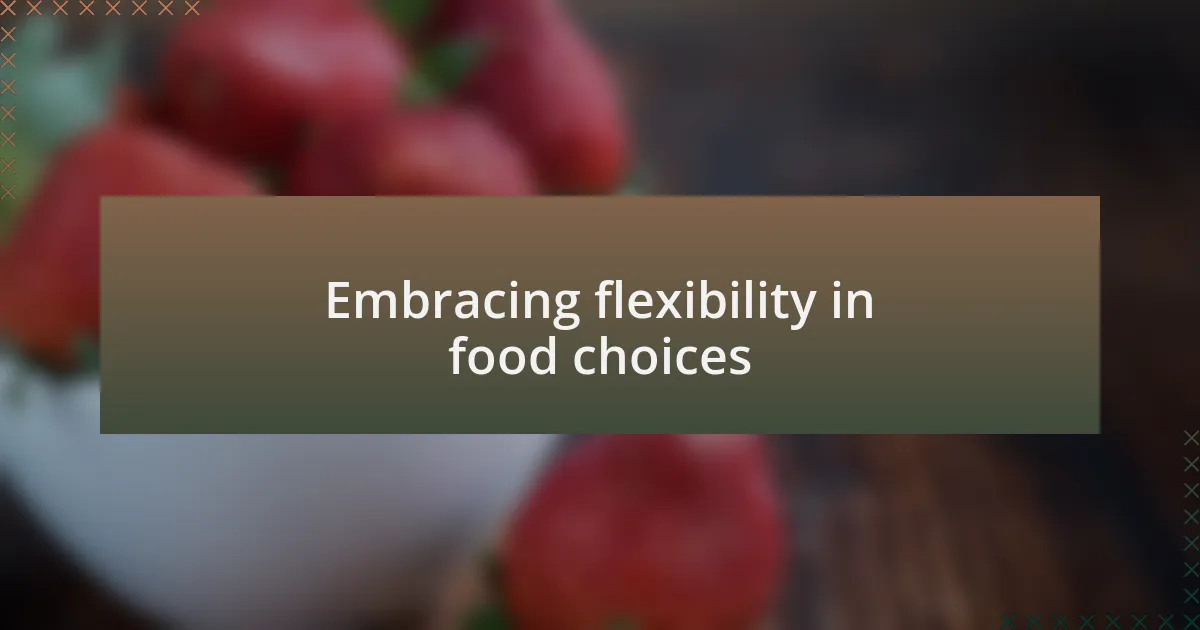
Embracing flexibility in food choices
Embracing flexibility in food choices has been one of the most liberating aspects of my intuitive eating journey. I remember a weekend when I found myself craving both a fresh salad and a slice of chocolate cake. Instead of forcing myself to choose one over the other, I decided to enjoy both. That moment taught me that food is not just about labels or strict rules, but about satisfying my cravings and nourishing my body at the same time.
There are days when my schedule gets hectic, and a homemade meal isn’t feasible. It used to panic me, but now I’ve learned to appreciate the flexibility of choosing healthy takeout or exploring new recipes. I often ask myself, “What’s available that excites my taste buds?” This shift in perspective encourages me to explore different options rather than viewing convenience as a compromise.
I’ve noticed that when I allow myself this kind of freedom, I feel more satisfied and grounded in my choices. For instance, the other night, I decided to throw together a dish using whatever I had on hand. It wasn’t a culinary masterpiece, but it was authentically satisfying. Hasn’t there been a time when an unexpected combination brought you joy? That spontaneity not only expands my palette but deepens my connection with food.